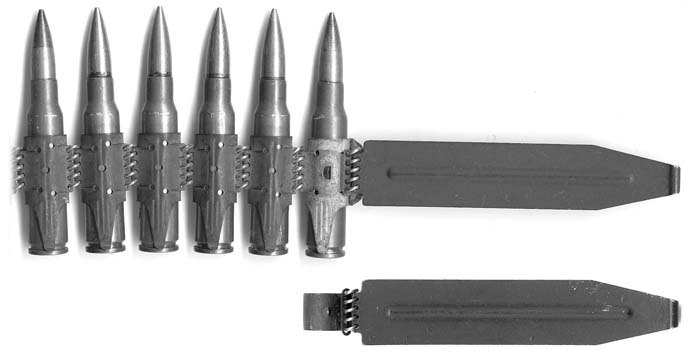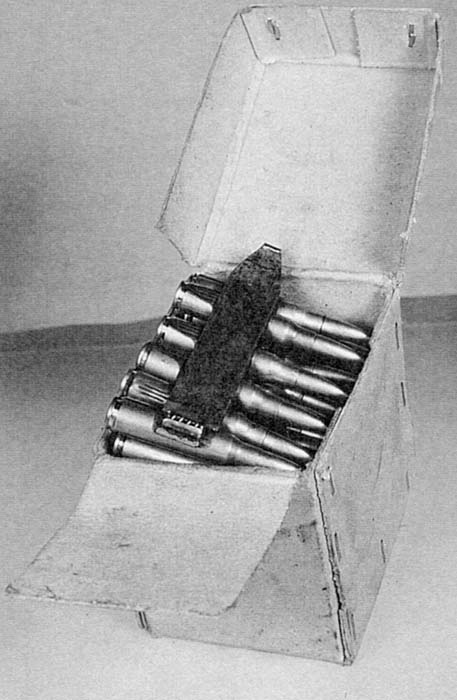By Jean-Francois Legendre
Frequently, 7.62x51mm NATO ammunition is encountered on odd, non-disintegrating belts. Here is the answer to why.
Continuous 50-Round Belts.
At the very beginning of the 1950s, the first belts used for developing the prototypes of the future AA-52’s were closely derived from the German belts for the MG34 & 42. They had a capacity of 50-rounds and could be connected to each other by means of male & female connecting links installed at both ends of the belt. The pitch between the cartridges is 17mm as for the German belts.
At least four main French variants of the 50-round continuous belts are observed from surviving specimens. The same belts were used for both 7.5×54 and 7.62×51.
The French belts show very close similarities to the German wartime Gurt 34/41 (see author’s article on German MG34 & 42 belts in SAR Vol. 8, No. 6, March 2005) with 3 lengthwise stiffening grooves, but unlike their German counterparts, the French belts are devoid of friction dimples.
The first and earliest French belts were manufactured by the Manufacture Nationale d’Armes de Saint-Etienne (MAS), probably using modified German wartime tooling.
In early 1953, the design was improved by the Manufacture Nationale d’Armes de Châtellerault (MAC) with an important modification of the female connecting link. The latter incorporates a re-curved lip which partly surrounds the connecting spring of the starter tab and also offers a rest to it. This was done in order to stiffen the junction between the belt and the starter tab. This one-of-a-kind shape of the female connecting link is the foremost evidence to readily identify a French 50-round belt.
The corresponding French starter tab is composed of an unmarked ribbed steel plate re-curved at one end and assembled with only the male connecting finger.
Early in 1954, the individual links were further modified by the addition of a 2mm hole in their center. This hole was added only in order to help exactly positioning the link in the tool during the stamping process and during the assembly with the coiled connecting springs. Unlike what could be sometimes read, this hole is absolutely not a means of any identification. The female connecting link remained unchanged.
Finally from the end of 1956 on when the AA-52 entered full production and were delivered in quantity to the Armed Forces, the final design of the 50-round belt was stabilized and officially approved. It is the same as the previous variant with the 2mm hole on the links but with the female connecting link cadmium-coated in order to give it a white outlook aimed at helping to readily locate the end of each 50-round section should a longer belt be assembled. The starter tab remained unchanged.
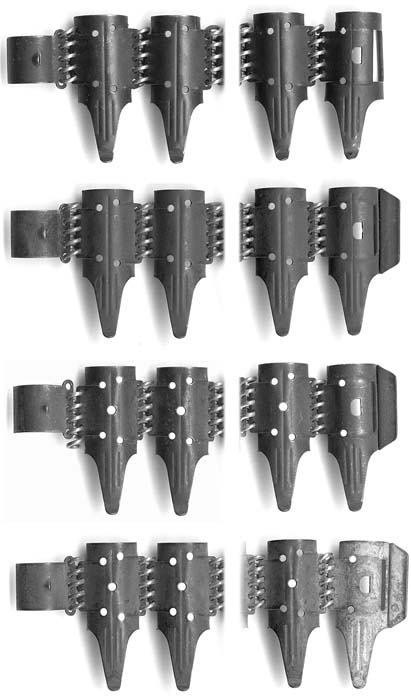
On all these 4 variants, the male connecting finger is unmarked and the links are phosphated. The continuous 50-round belts remained used with combat ammunition only for a short period of time until the end of 1959-60 when they were mostly replaced with belts assembled with disintegrating links.
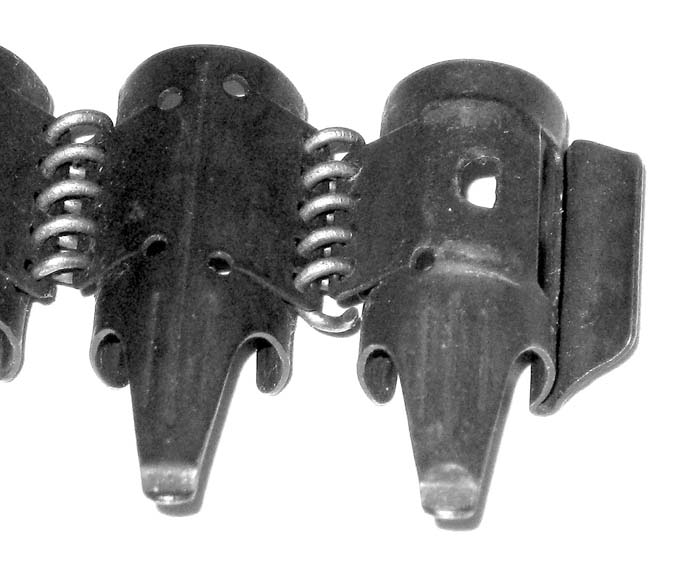
Detail of the female connecting link designed by MAC early 1953. 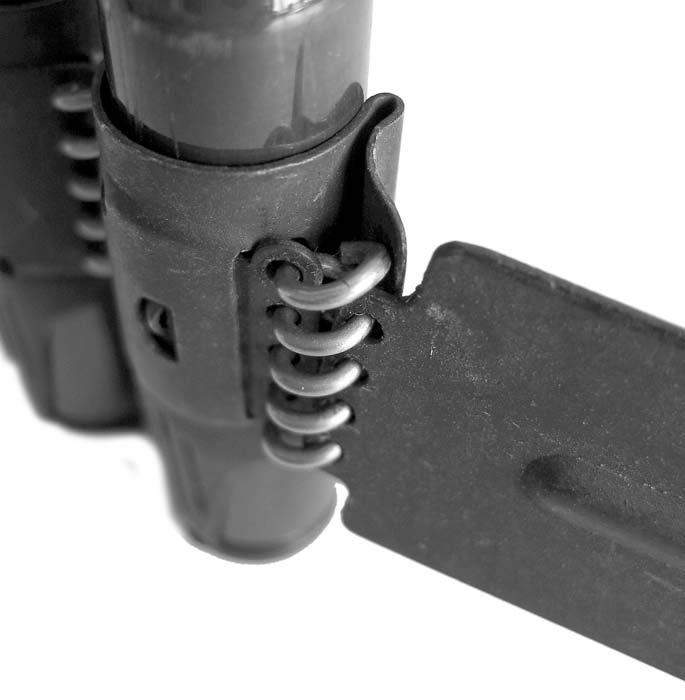
Assembly of the starter tab on the improved female connecting link.
The 50-round continuous belts remained however in service as an accessory for training at a ratio of 3 belts issued per blank-firing accessory pack. Belts were repeatedly reloaded manually with the plastic blank ammunition both in caliber 7.5×54 and 7.62×51. In February 1973, the continuous belts were officially removed from the blank-firing accessory pack since from that time on all plastic blanks were issued pre-belted in disposable disintegrating 50-round belts.
For AA-52s used in the Light Machine Gun configuration, several experiments were conducted in 1953-55 to design a container that could accommodate a 50-round continuous belt and which could be fastened to the left side of the feed-block. Unlike the German WW2 type of belt drum used with MG34 & 42 where the belt is rolled around itself, the French have chosen the principle of a cubic box with the belt folded on several layers. Both cardboard and metallic cubic boxes are known from test reports, but the author has been unable so far to examine any surviving specimens.
Disintegrating links
In 1954, a disintegrating link was also designed for the AA-52 in caliber 7.5×54. This disintegrating link is of the hook-and-eye pattern and shows very close similarities with the latest variant of wartime German Gurt 17/81 for the MG17 & 81 (see author’s article on German MG17 & 81 belts in SAR Vol. 8, No. 2, November 2004). The pitch between the cartridges is 17mm like that of the continuous 50-round used with the infantry weapons. The key design difference between the last variant of the German wartime Gurt 17/81 and the French link is the shape of the end of the tongue which fits into the cartridge case extracting groove. For the German link, positioning in the extracting groove is achieved by a small dimple stamped into the link whereas for the French link, the end of the tongue is simply re-curved in V-shape. Obviously the other difference readily visible is the markings on the links. The prototype disintegrating links for AA-52 were produced by the Manufacture Nationale d’Armes de Châtellerault (MAC) and are devoid of any marking.
In 1959, the disintegrating links were officially adopted for combat use with 7.5×54 ammunition. Mass production links are marked with the weapon designation, i.e., “AA52” as well as with the manufacturer’s code. At least six different disintegrating link manufacturers codes are observed from specimens: PV (Peugeot in Valentigney), RD (Raymond in Grenoble), GG (Georges Groslambert in Besançon), PRI and ROS (Philippe Rossi Industries in Marseilles) and SAV (Savigny). Different surface coatings for protection against corrosion were used: green or black phosphate, gloss dark green or gloss black lacquer and more rarely zinc-chromate. From the mid 1980s on, the marking pattern on the links was changed to display only the manufacturer code and lot number+year of production. It must be emphasized that the same link was used both with 7.5×54 and 7.62×51 ammunition.

Three different types of starter tabs were used. The earliest one is composed of an unmarked ribbed steel band fitted at one end with a small loop that fits into the hook of the first link of the belt and on the other side a bigger loop which can be grabbed by the fingers of the gunner. This 1st model of starter was used with pre-packed combat ammunition 50-round belts loaded with 7.5×54 rounds. This design basically required that a cartridge is extracted from the first link in order to install or remove the starter tab from the belt.
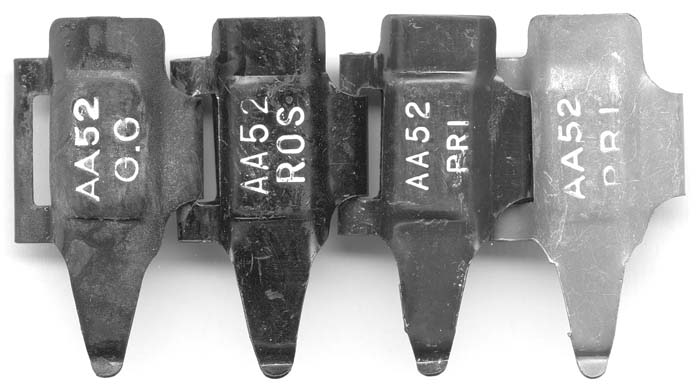
A selection of surface coatings: black phosphate, gloss black lacquer, gloss green lacquer and zinc-chromate. 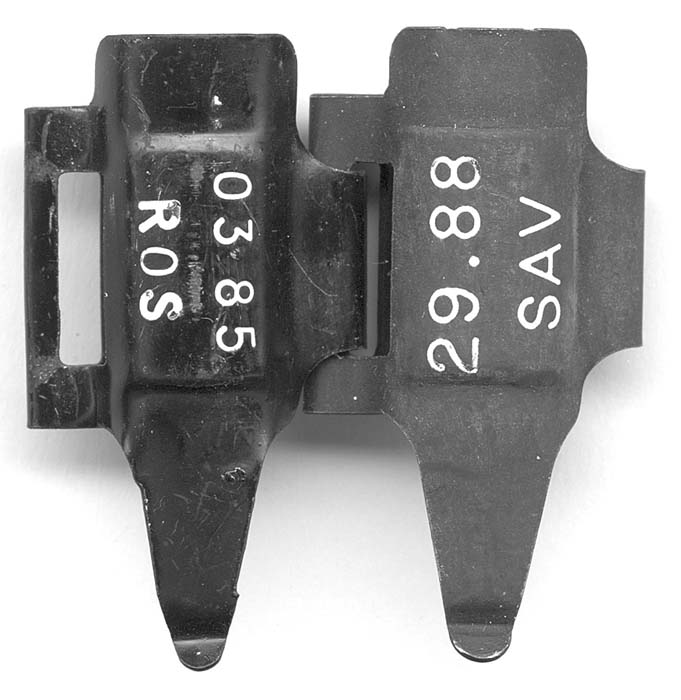
From the middle of the 1980s on, marking pattern on the links was changed to indicate the manufacturer code and lot number + year of production. So far those late productions have been observed from SAV and ROS.
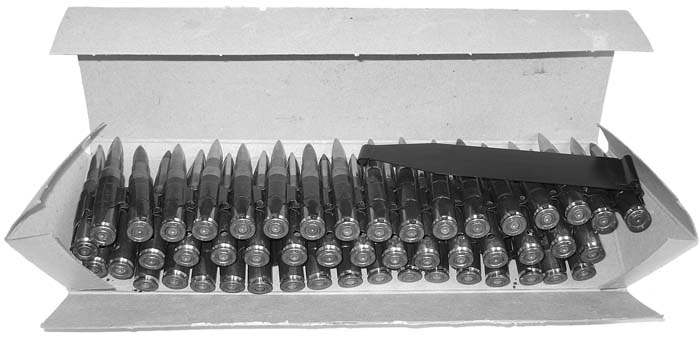
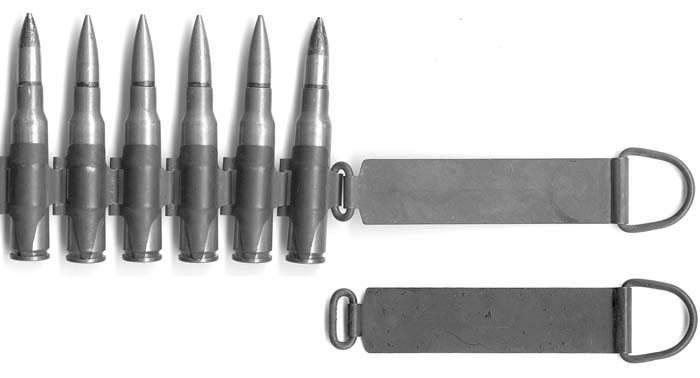
In order to avoid that, a 2nd starter variant appeared around 1963-64 that is composed of a flat steel band with a re-curved end to help grabbing by hand and on the other end is fitted with a piece with a slot which can be slipped in or out from the hook of the first link of the belt without removing the cartridge. This second type of starter remained unchanged until the latest productions and was used both with 7.5×54 and 7.62×51 pre-packed combat ammunition 50-round belts. These starters usually bear no marking. However, some pre-packed belts issued to the French Navy sometimes bear markings in white paint either with a wing-and-anchor logo to show issue to the Navy or with lot identification data for belts loaded with blank cartridges.
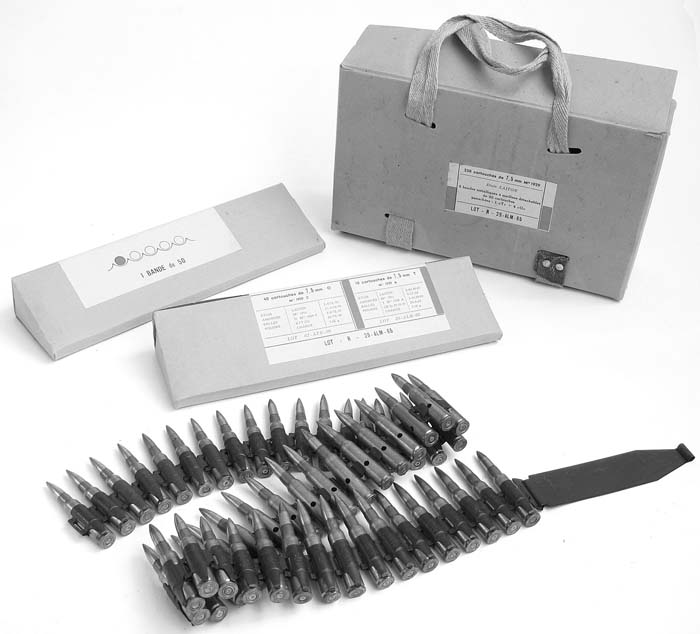
Typical packing of the 1960s with triangular cardboard box containing one 50-round disposable belt and the cardboard carrying box for 5 triangular boxes (total capacity 250 rounds). 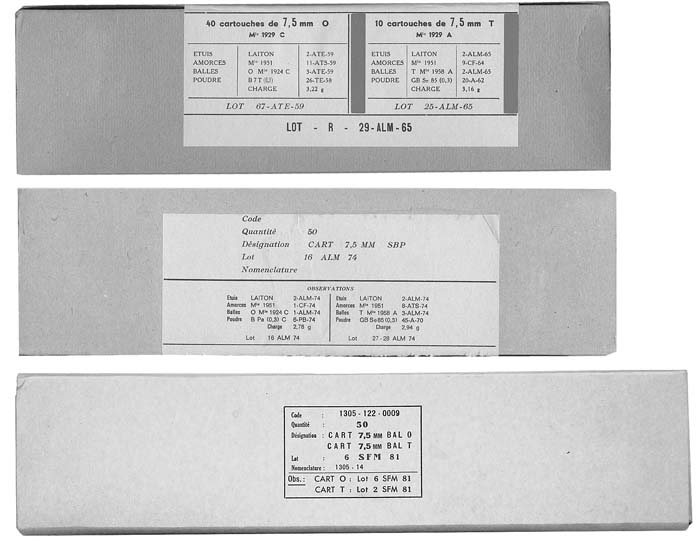
Finally a third type of starter saw only very limited use. It was officially adopted in August 1970 to enable the loading of the AA 7.62 N F1 fitted coaxial to the 75mm gun of the tank AMX 13/FL10E. The mounting of the machine gun was so cramped that the standard rigid starter could not be used. Accordingly, a dedicated starter was designed, composed of only a 2cm portion of a standard starter and then fitted to a 20-cm long fabric strip therefore enabling to fold it out of the feed block. According to the requirement of this starter in only a very limited number of tanks, instructions were provided to the unit armorers for the hand production of the starter by shortening standard issued starters and the riveting of a fabric strip. From 1959 on, most combat ammunition for the infantry was issued in prepacked disposable 50-round belts with disintegrating links. The typical packing encountered in the 1960s and 1970s corresponds to a single 50-round disintegrating linked belt, fitted with a starter tab, packed in three folds into a triangular shaped cardboard box contained in a transparent sealed plastic bag. Five of these sealed triangular boxes are stored in a cardboard box (total content 250 rounds) fitted with fabric carrying handles. Two of these 250-round cardboard boxes are installed in a steel can (total capacity of 500 rounds) and finally two of these steel cans are transported in a wire-bound wood frame (total capacity of 1,000 rounds).
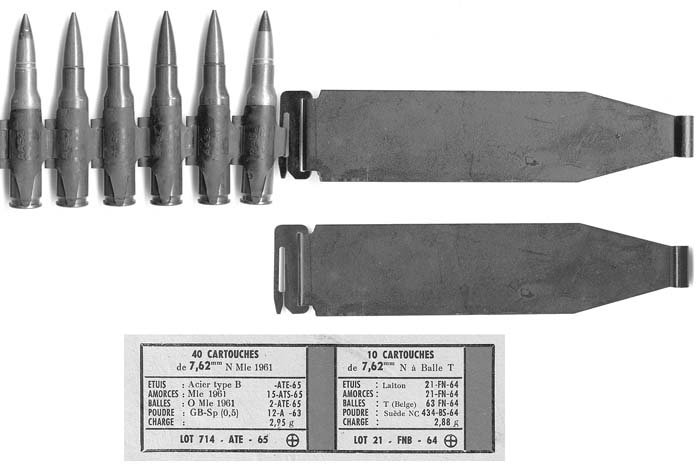
From the early 1980s on, the length of the triangular cardboard box was slightly increased and the belt could accordingly be packed in 2 1/2 folds only in the box also contained inside a transparent sealed plastic bag. Six of these sealed triangular boxes are stored in a cardboard box (total content 300 rounds) fitted with fabric carrying handles. Finally two of these 300-round cardboard boxes are installed in a steel can with a removable lid (total capacity 600 rounds).
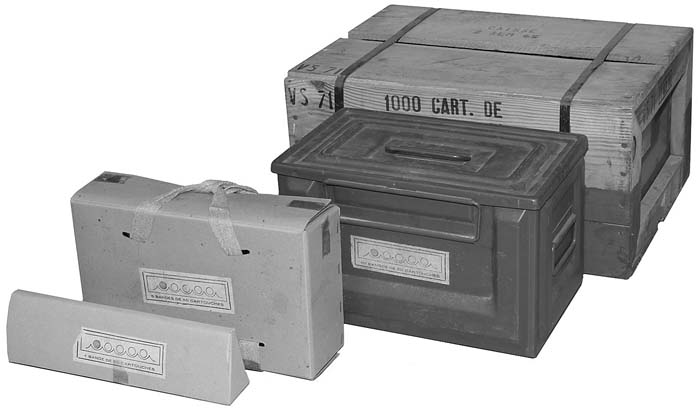
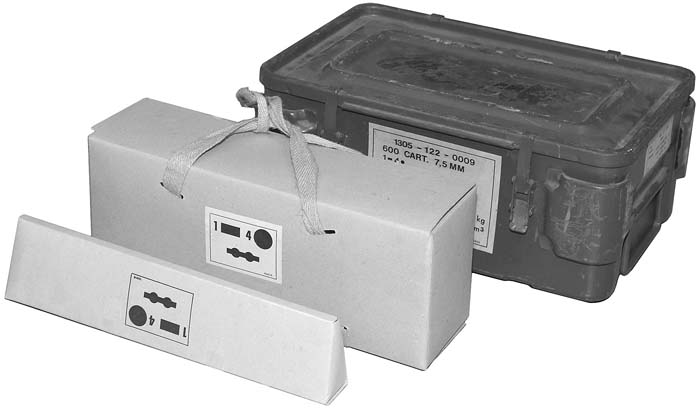
Both 7.5×54 and 7.62×51 ammunition were delivered in these pre-packed 50-round disposable belts. Standard belting sequence for both calibers was 1 tracer + 4 ordinary balls. More rarely pre-packed belts loaded with only ordinary balls are also observed.
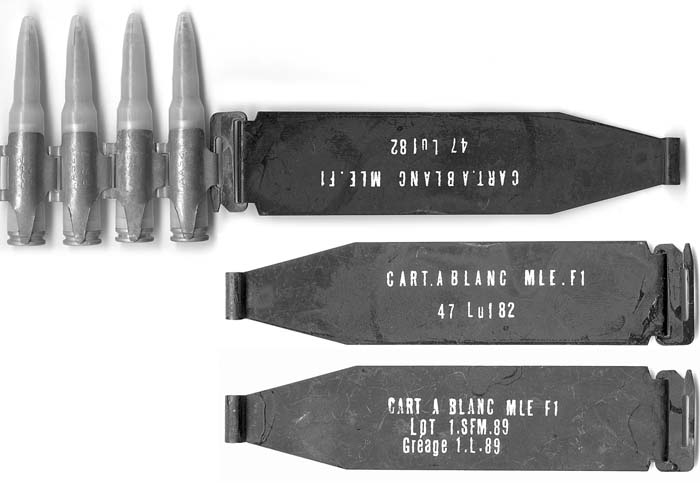
The feeding of AA-52 in the Light Machine Gun configuration was achieved from one 50-round disposable belt carried in a rectangular green fabric pouch attached to the left side of the feed block. This configuration of feeding is the most commonly encountered on pictures taken during combat in Algeria around 1960.
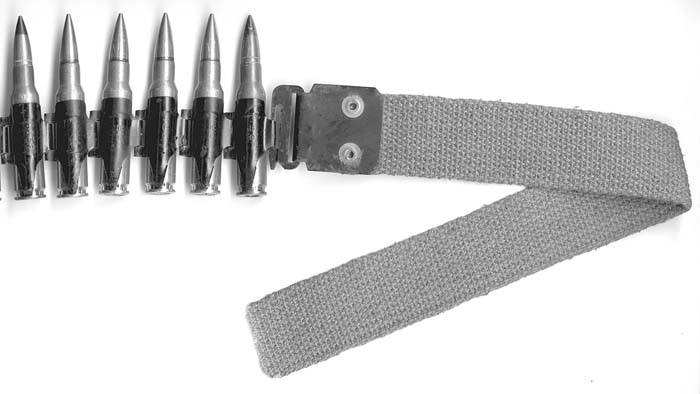
The feeding of the AA-52 in vehicle mounts was usually achieved from 250-round capacity steel cans. These re-usable cans were filled prior to use with the pre-packed 50-round belts assembled together to the required length.

Although no official information could be found about that issue, the high-capacity belts with disintegrating links used by the Air Force onboard airborne platforms (aircraft or helicopter) were probably belted from loose ammunition within the flying unit armories.
Prior to the official adoption by France of the AA-52 chambered in 7.62×51 NATO, extensive experiments on interchangeable feed systems within the various NATO machine guns were undertaken between 1959-1962. Accordingly, different prototype links were specifically developed by the Manufacture Nationale d’Armes de Châtellerault for the 7.62×51 NATO cartridges and tested for interchangeability with the German MG3, U.S. M60 and Belgian MAG. Among the numerous prototypes, it is worth mentioning a close variant of the standard AA-52 links but bearing a reduced pitch of 14.7mm instead of the standard 17mm. This reduced pitch was meant to correspond to the pitch of the U.S. M13 links for the M60. Other variants have also been developed in cooperation with the Belgians with a pitch of 15.5 and 16mm; those links were commonly referred to as “Franco-Belgian links”.
.50 Caliber Belts and Links
The .50 caliber weapons designed by the Manufacture d’Armes de Châtellerault is a scaled-up version of the AA-52. Accordingly, it is not a big surprise that the feed systems used are also scaled-up versions of the 7.5/7.62 belts and links. The first type of belts are continuous 50-round belts that could be connected to each other by means of male finger and female link. The female link corresponds to a scaled-up version of that used for the Model of 1954 with the re-curved side. The starter tab is also of the same pattern with only the male connecting finger. Two types of stamping patterns are observed on the .50 links, both also bearing the small hole to help positioning during the manufacturing process. The male connecting finger is also unmarked. From 1957 on, disintegrating links were also investigated. The first model is exactly a scaled-up version of the 7.5/7.62 link, however also fitted with the small hole. In 1959, an enhanced prototype of disintegrating link was designed in order to increase the grip of the link on the .50 caliber cartridge. The hook-end-eye pattern was kept but the link encloses the cartridge case more tightly at two clamping positions. A .50 caliber starter tab for the disintegrating link has also been designed but no surviving specimen was observed so far by the author.

Belt bag fastened to the AA-52 in Light Machine Gun configuration. (Courtesy JMG) 
Typical 250-round steel can as used on vehicles. These cans are repeatedly refilled with 250-round belts assembled from pre-packed 50-round disposable belts. (Courtesy Koen Bakker)





Belt Loading Machines
At the first stages of development of the AA-52 in the early 1950s, German wartime Gurtfüller 34 were used during the trial period. It is only around 1957-58 that a small batch of belt loading machines designed by the company Peugeot was put in production. The official designation of that machine was “Assembleuse de Bandes Peugeot Type 10” (Peugeot belt assembling machine type 10) and was dedicated to the 7.5×54 caliber. It remains still unclear for which precise application this machine was designed. It can be noted that, so far, reference to this belt loading machine has only been observed in French Air Force armament inventory files. It is possible that this machine was in use in Air Force base armories to assemble the long belts for use with aircraft guns. However, it must be emphasized that the cartridges are fed in bulk in a kind of hopper, which does not enable the organization of any belting sequence mixing different types of ammunition (tracer, incendiary, etc.). Both continuous belts and pre-assembled belts with disintegrating links could be loaded with that machine. A distinctive feature is that two links are filled simultaneously during one rotation of the handle. The latter could be assembled either on the side of the machine or on the front in order to cope with any configuration of the workbench on which the machine was affixed. This machine has an extremely smooth and reliable operation. The three different specimens of such loaders ever examined by the author are painted light grey and were manufactured at the end of 1957 through early 1958. This type of belt loading machine is now an extremely scarce collectors’ item in France.


| This article first appeared in Small Arms Review V11N10 (July 2008) |





